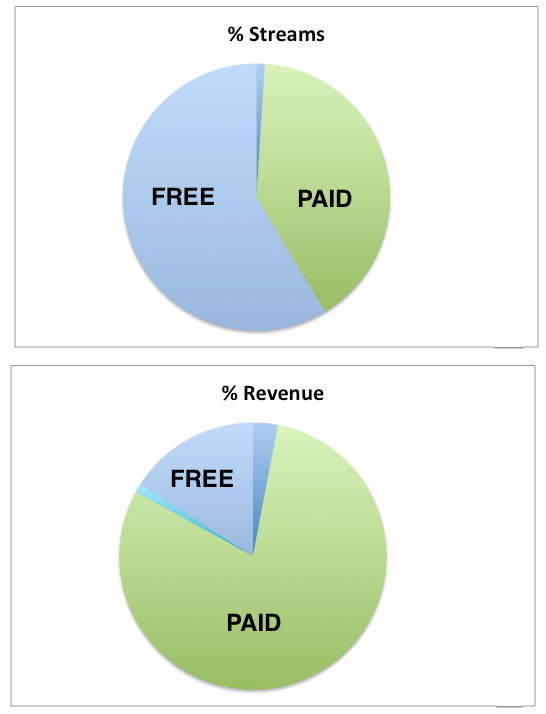Why What’s Good for Adele, Sucks For Everyone Else
We often celebrate artists like Adele and Taylor Swift for leading the music industry in a direction of positive change, but the realities of income redistribution mean that their business model, while admirable and certainly successful, is difficult for artists who aren't at a similar level of stardom to emulate.
___________________________________
Guest Post by David Lowery on The Trichordist
We celebrate in all the success that Adele deserves. Like Taylor Swift and Beyonce’ before her the ladies are leading the industry with common sense. We applaud all three for windowing their new albums off of Spotify and other FREE streaming services. We also have some concerns about the implications for other artists who currently can’t do the same.
It would appear the new way to sell music and make money is the same as the old way to sell records and make money. Make a great record, don’t give it away for free, and partner with a major label.
Of course there are those who might say that the success of these female artists is due to the fact that they also have a female audience. One could argue that there are far fewer women pirates and that alone is a key factor in driving these types of phenomenal sales figures. Perhaps women are more mature consumers than their butt scratching, booger eating male counter parts however these types of pop music sales generally transcend demographic limitations.
But what works for Adele, Taylor Swift and Beyonce may not work for other artists and here’s why – it’s called income redistribution. The top 1% of artists are capturing 77% of recorded music revenues. That means everyone else, the remaining 99% of artists are dividing up the remaining 23% of recording revenues among them. In short, that leaves an ecosystem with superstars on one end of the spectrum and hobbyists on the other and not much of a middle class in-between.
The Top 1% of Artists Earn 77% of Recorded Music Income, Study Finds… | Digital Music News
In other words, the exact opposite of the Long Tail, a theory that seemed exciting at the time but has now been thoroughly disproven (MIDiA’s report is titled The Death of the Long Tail: The Superstar Music Economy).
Perhaps the larger irony here is that those who sought to destroy the major labels through piracy have only empowered them. The major labels now not only capture the larger share of revenue from recorded music but also as a result they also capture the most favorable deal terms (including equity shares) from the digital service providers (DSP). The net result being that indie and DIY artists who once accounted for a robust middle class of musicians have been pushed down into the realm of hobbyists. Of those few, rare indie/DIY outliners that manage to flourish none of them will get equity stakes or the same terms that the major labels do from the DSP’s.
There is no internet empowerment for professional musicians. There is no democratization of music in creating a new and robust ecosystem of middle class professional musicians. Internet piracy and the new “digital music economy” have only created equality when everyone is equally poor. That’s a pretty lame revolution.
Revenge Of The Record Labels: How The Majors Renewed Their Grip On Music | Forbes
FORBES estimates that the three labels have amassed positions in digital music startups valued at almost $3 billion–or around 20% of the $15 billion or so the labels are collectively worth. The percentage will shoot even higher if and when Spotify goes public. And some bets have already paid off: Universal Music Group took an early position in Beats by Dr. Dre and owned 13% when Apple bought the company for $3 billion last year, resulting in a $404 million score.
WINDOWING THAT WORKS FOR EVERYONE
So what does this mean for the non-superstar artists? Very simply, windowing works. Windowing works better when there is a reasonable amount of consistency. Our friends in the film business have been highly effective at windowing for decades and there’s no reason why it can’t work similarly well for the record business.
Every new release should have the option to determine the release windows when the record is being set up. For example the default could be 0,30,60,90 day option for transactional sales, followed by 0,30,60,90 day option for Subscription Streaming prior to being available for Free Streaming.
Windowing is not new for the record business. The industry has never had pricing ubiquity across all releases, genres and catalogs. There have always been strategic and flexible pricing strategies to differentiate developing artists, hits, mid-line catalog, and deep catalog. An industry wide initiative to re-allign time proven price elasticity is the key to growing the business and developing a broad based sustainable ecosystem for more artists.
- Windowing allows for Free Streaming to exist as a strategic price point.
- Windowing allows for Subscription Streaming to exist as a strategic price point.
- Windowing allows for Transactional Downloads to exist as a strategic price point.
- Windowing allows for artists and rights holders to determine the best and most mutually beneficial way to engage with their fans.
Windowing is the key (as it always has been) in rebuilding a sustainable and robust professional middle class that will inevitably lead to more artists ascending to the ranks of stars. Some will become superstars and legends capable of creating the types of sales and revenues currently achieved by Adele, Taylor Swift and Beyonce’. To get there however we need to abandon Stockholm Syndrome and embrace windowing that works for everyone.
This one chart says it all…

—
—————> http://www.TaylorSwiftSucks.xxx
—————> http://www.TaylorSwiftSucks.xxx
.
—————> http://www.TaylorSwiftSucks.xxx
—————> http://www.TaylorSwiftSucks.xxx
—————> http://www.TaylorSwiftSucks.xxx
—
As does Adele
Adeles voice is like nails on a blackboard. Horrendous, terribly annoying and unpleasant. Her music makes me physically ill.
Can’t stand to listen to her cry…I mean sing.